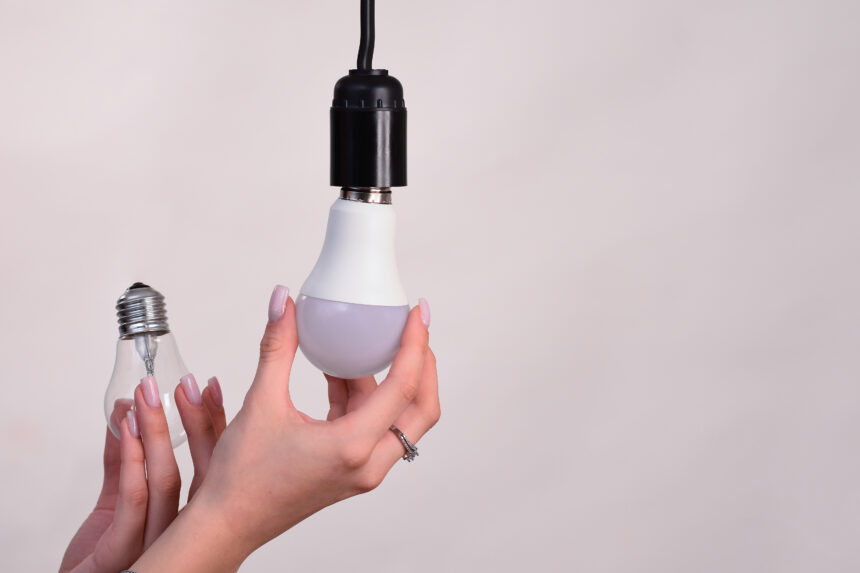LED (Light Emitting Diode) lighting has revolutionized energy efficiency in lighting systems, offering significant benefits over traditional incandescent and fluorescent bulbs. Here’s how LED lighting contributes to energy savings:
LEDs are highly efficient: LEDs convert more electrical energy into light than incandescent bulbs, which lose a lot of energy as heat. This efficiency translates directly into lower electricity usage and reduced energy bills.
Longevity: LED bulbs can last significantly longer than traditional bulbs, reducing the frequency of replacements and associated maintenance costs. This longevity not only saves money but it also decreases the effect of manufacturing and disposing of bulbs in the environment.
Versatility: LEDs come in variety of shapes and sizes and are suitable for different lighting needs, from ambient lighting to task lighting and decorative purposes. Their versatility allows for tailored lighting solutions that further optimize energy usage.
Instantaneous lighting: Unlike CFLs (Compact Fluorescent Lamps) which may take time to reach full brightness, LEDs can provide instant light, enhancing convenience and reducing energy waste.
Directional lighting: LEDs emit light in a specific direction, unlike conventional bulbs that emit light and heat in all directions. This directional feature reduces the need for reflectors and diffusers, further improving efficiency.
Environmental benefits: LED lighting reduces carbon dioxide emissions and other pollutants associated with electricity generation. Its long lifespan and reduced energy consumption contribute to sustainability efforts and conservation of natural resources.
Using LED lighting offers numerous benefits that make it a superior choice compared to traditional incandescent and fluorescent bulbs. Here are the key reasons to switch to LED lighting:
1. Energy Efficiency
- Lower Energy Consumption: LEDs use significantly less energy to produce the same amount of light as incandescent or fluorescent bulbs, leading to substantial energy savings.
- Reduced Carbon Footprint: Lower energy consumption translates to reduced greenhouse gas emissions, contributing to a smaller carbon footprint and a positive environmental impact.
2. Cost Savings
- Longer Lifespan: LEDs last much longer than traditional bulbs, reducing the frequency of replacements and associated costs. While an incandescent bulb might last around 1,000 hours, an LED can last up to 25,000 hours or more.
- Lower Electricity Bills: The energy efficiency of LEDs leads to lower electricity bills, providing significant cost savings over time, especially in households and businesses with high lighting demands.
3. Durability and Reliability
- Robust Design: LEDs are more durable and resistant to breakage compared to glass bulbs, making them ideal for various environments, including outdoor settings and areas prone to vibration or impact.
- Consistent Performance: LEDs provide consistent and reliable lighting without flickering, enhancing visual comfort and reducing eye strain.
4. Environmental Benefits
- Reduced Waste: The extended lifespan of LEDs means fewer bulbs need to be produced and disposed of, reducing waste in landfills.
- No Harmful Chemicals: Unlike fluorescent bulbs, LEDs do not contain mercury or other hazardous substances, making them safer for the environment and easier to dispose of.
5. Better Light Quality
- Variety of Color Temperatures: LEDs are available in a range of color temperatures, from warm white to cool daylight, allowing for versatile lighting design and ambiance creation.
- Instant On: LEDs light up instantly to full brightness without the warm-up time required by some other types of bulbs, providing immediate and efficient illumination.
6. Enhanced Control Options
- Dimming Capabilities: Many LED bulbs are compatible with dimmer switches, offering flexible lighting levels to suit different needs and moods while saving energy.
- Smart Lighting Integration: LEDs can be easily integrated into smart home systems, allowing for advanced control options such as scheduling, remote operation, and automated lighting.
7. Heat Reduction
- Lower Heat Output: LEDs produce very little heat compared to incandescent bulbs, which release 90% of their energy as heat. This reduces the cooling load on air conditioning systems and enhances safety by minimizing the risk of burns and fire hazards.
The adoption of LED lighting offers substantial energy savings, enhanced durability, and environmental benefits. As technology continues to advance, LEDs remain at the forefront of efficient lighting solutions, providing both economic and ecological advantages for homes, businesses, and communities alike.




